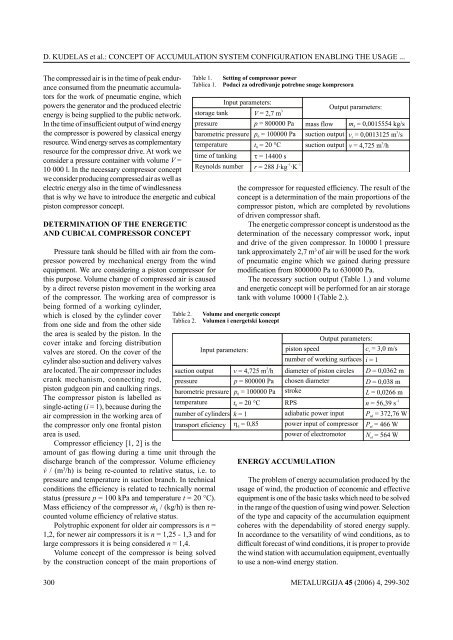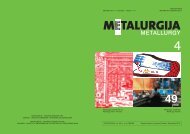pdf - 14652 kB - CARNet
pdf - 14652 kB - CARNet
pdf - 14652 kB - CARNet
Create successful ePaper yourself
Turn your PDF publications into a flip-book with our unique Google optimized e-Paper software.
D. KUDELAs et al.: CONCEPT OF ACCUMULATION sYsTEM CONFIGURATION ENABLING THE UsAGE ...<br />
The compressed air is in the time of peak endurance<br />
consumed from the pneumatic accumulators<br />
for the work of pneumatic engine, which<br />
powers the generator and the produced electric<br />
energy is being supplied to the public network.<br />
In the time of insufficient output of wind energy<br />
the compressor is powered by classical energy<br />
resource. Wind energy serves as complementary<br />
resource for the compressor drive. At work we<br />
consider a pressure container with volume V =<br />
10 000 l. In the necessary compressor concept<br />
we consider producing compressed air as well as<br />
electric energy also in the time of windlessness<br />
that is why we have to introduce the energetic and cubical<br />
piston compressor concept.<br />
DETERMINATION OF THE ENERGETIC<br />
AND CUBICAL COMPRESSOR CONCEPT<br />
Pressure tank should be filled with air from the compressor<br />
powered by mechanical energy from the wind<br />
equipment. We are considering a piston compressor for<br />
this purpose. Volume change of compressed air is caused<br />
by a direct reverse piston movement in the working area<br />
of the compressor. The working area of compressor is<br />
being formed of a working cylinder,<br />
which is closed by the cylinder cover<br />
from one side and from the other side<br />
the area is sealed by the piston. In the<br />
cover intake and forcing distribution<br />
valves are stored. On the cover of the<br />
cylinder also suction and delivery valves<br />
are located. The air compressor includes<br />
crank mechanism, connecting rod,<br />
piston gudgeon pin and caulking rings.<br />
The compressor piston is labelled as<br />
single-acting (i = 1), because during the<br />
air compression in the working area of<br />
the compressor only one frontal piston<br />
area is used.<br />
Compressor efficiency [1, 2] is the<br />
amount of gas flowing during a time unit through the<br />
discharge branch of the compressor. Volume efficiency<br />
v / (m3 /h) is being re-counted to relative status, i.e. to<br />
pressure and temperature in suction branch. In technical<br />
conditions the efficiency is related to technically normal<br />
status (pressure p = 100 kPa and temperature t = 20 °C).<br />
Mass efficiency of the compressor m k / (kg/h) is then recounted<br />
volume efficiency of relative status.<br />
Polytrophic exponent for older air compressors is n =<br />
1,2, for newer air compressors it is n = 1,25 - 1,3 and for<br />
large compressors it is being considered n = 1,4.<br />
Volume concept of the compressor is being solved<br />
by the construction concept of the main proportions of<br />
300<br />
the compressor for requested efficiency. The result of the<br />
concept is a determination of the main proportions of the<br />
compressor piston, which are completed by revolutions<br />
of driven compressor shaft.<br />
The energetic compressor concept is understood as the<br />
determination of the necessary compressor work, input<br />
and drive of the given compressor. In 10000 l pressure<br />
tank approximately 2,7 m 3 of air will be used for the work<br />
of pneumatic engine which we gained during pressure<br />
modification from 8000000 Pa to 630000 Pa.<br />
The necessary suction output (Table 1.) and volume<br />
and energetic concept will be performed for an air storage<br />
tank with volume 10000 l (Table 2.).<br />
ENERGY ACCUMULATION<br />
The problem of energy accumulation produced by the<br />
usage of wind, the production of economic and effective<br />
equipment is one of the basic tasks which need to be solved<br />
in the range of the question of using wind power. selection<br />
of the type and capacity of the accumulation equipment<br />
coheres with the dependability of stored energy supply.<br />
In accordance to the versatility of wind conditions, as to<br />
difficult forecast of wind conditions, it is proper to provide<br />
the wind station with accumulation equipment, eventually<br />
to use a non-wind energy station.<br />
METALURGIJA 45 (2006) 4, 299-302
















